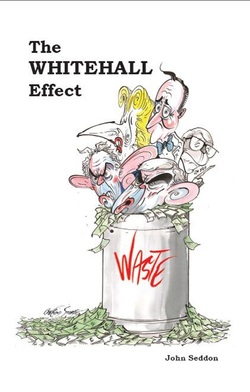The Whitehall Effect ~ John Seddon - Online Notes
|
Links below take you to the chapter notes:
Introduction 1. Prelude Part 1: The industrialisation of public services 2: Call centres 3. Back Offices 4. Shared Services 5. Outsourcing 6. Information Technology Part 2: Delivering services that work Introduction 7. A better philosophy 8. Effective change starts with ‘study’ 9. Better thinking, better design 10. ‘Locality’ working 11. IT as pull, not push Part 3: Things that make your head hurt 12. Targets and standards make performance worse 13. Inspection can’t improve performance 14. Regulation is a disease 15. It’s the system, not the people 16. Incentives always get you less Part 4: ideology, fashions and fads 17. Choice 18. Personal Budgets 19. Commissioning 20. Managing demand 21. Nudge 22. Procurement 23. Risk management 24. Lean 25. IT: features over benefits Part 5 Change must start in Whitehall 26. Beware economists bearing plausible ideas 27. Whitehall is incapable of doing evidence 28. Getting a focus on purpose |
17. Choice
1] David Cameron MP speech 11 July 2011, ‘Open Public Services’. View 2] The paper cited by Cameron in his speech is: Zack Cooper et al., ‘Does Hospital Competition Save Lives? Evidence from the English NHS Patient Choice Reforms’ Working Paper No. 16/2010, first published in January 2010 by LSE Health. View The paper was strongly criticised by Allyson Pollock and her colleagues in The Lancet, where the authors said that: ‘Although Cooper and colleagues claim to examine the impact of patient choice, they do not ascertain whether choice significantly affected the destination of patients… Crucially, the study lacks plausibility because Cooper and colleagues produce no explanation of any causal mechanism or path by which choice of provider for elective care could have affected outcomes for AMI in the NHS… Far from showing that competition saves lives, at best Cooper and colleagues’ study shows that people who have an AMI and whose GPs are close to a hospital or who have many hospitals in their area might have better chances of survival. The policy solution is therefore very different from that currently being followed.’ See Allyson Pollock et al., 2011, ‘No evidence that patient choice in the NHS saves lives’, The Lancet, Vol. 378 December 17/24/31, 2011 pp.2057-2060. 3] John Seddon, 2008, Systems Thinking in the Public Sector: the failure of the reform regime and a manifesto for a better way, Triarchy Press, p.24. 4] These figures come from John Curtice and Oliver Heath, 2009, ‘Do people want choice and diversity of provision in public services?’ in Alison Park et al. (eds) British Social Attitudes: the 25th Report, Sage, p.60: “For example, we asked our respondents to state which of a set of four possible priorities for the NHS was ‘most important for the NHS to achieve’. No less than 78% chose ‘make sure people who are ill get treatment quickly’. In contrast, just six per cent say ‘make sure people have a lot of choice about their treatment and care’, slightly less than the seven per cent who opt for ‘make sure that people on low incomes are as healthy as people on high incomes’, though rather more than the two per cent who choose ‘get the number of people aged under 50 with heart disease down as low as possible’.” 5] John Seddon, 2008, Systems Thinking in the Public Sector: the failure of the reform regime and a manifesto for a better way, Triarchy Press, p.17. 6] For example: Tom Gash and Theo Roos, 31 August 2012, Choice and competition in public services: Learning from history, Institute for Government. View The authors say: “One problem in assessing the impact of market mechanisms was the general lack of any systematic evaluation of whether competition in itself raises standards. Academics on our panels could point to indicative evidence from evaluations of different contracting models but were rarely able to highlight pilots which directly tested the benefits of contractual approaches versus in-house provision. This is partly due to the fact that reform (and refusal to reform) has often been driven by political concerns and ideology but it is also, no doubt, due to the technical difficulty, time and cost of such exercises’. Also the New Statesman’s rolling politics blog, 4 April, 2012, ‘The problem with public service “choice”’. Byline. Prateek Buch. View Buch says: “For every unpublished, non-peer-reviewed study that claims to show how choice and competition raise standards, you can find many rebuttals that expose methodological and empirical flaws. Take the now infamous studies claiming that competition for elective surgery (indexed not by a measure of choice itself but by geographic density of hospitals, a poor proxy at best) improves outcomes in mortality from heart attacks (through an unspecified mechanism); the papers show weak statistical correlations at best, not a causal relationship, and yet they’re unquestioningly cited as evidence that ‘hospitals in more competitive areas perform better on quality and efficiency than those in less competitive ones’.” 7] An NHS guidance paper from April 2014 says this: “New legal right to choice of mental health provider: From 1 April 2014, patients have a new legal right to choose the provider of their mental health services at first outpatient appointment, as they do in their physical health care.” View 8] Laird Ryan, May 2014, NCIA Inquiry into the Future of Voluntary Services: Working Paper 5 Outsourcing and the Voluntary Sector. View Other papers on the subject of the future of voluntary services are to be found on the National Coalition for Independent Action webpages. View Additional evidence of the impact of commissioning on third sector organisations can be found in the report by Locality and Vanguard, 2014, Saving money by doing the right thing: Why ‘local by default’ must replace ‘diseconomies of scale’, p.14. View 9] David Boyle, 24 January 2013, The Barriers to Choice Review: How are people using choice in public services?, Cabinet Office. View |

